WORLD CLASS COACHING
Club Curriculum U9/10 Season
By Tony Englund
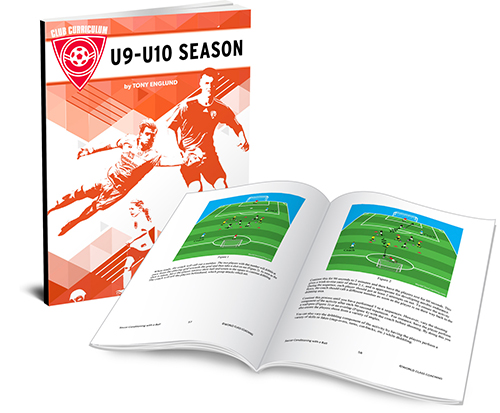
TABLE OF CONTENTS
Part Four
TECHNICAL SESSIONS
ABOUT THE AUTHOR
Training Session #14: Passing and Receiving.
Introduction: Session#14 revisits the skills of passing and receiving through fun games designed to apply time and opponent pressure, and emphasize accuracy, to the attacker’s efforts.
Pac man - 20x20 yard grid
Two players are “Pac men” to start. All players have a ball and the Pac men wear distinctive vests. In this game, players dribble their balls around the grid and the Pac men try to kick their own soccer balls to hit the balls of the dribbling players. If their ball is struck, the players then put on a vest and join the Pac team until all players have been caught. It is critical to emphasize safety here. All balls must remain on the ground throughout the exercise.
Pairs Passing Contests - 20x20 yard grid
Players work in pairs along the touch-line. Conduct thirty second contests with the themes outlined below. No player may cross the line at any time, and each successful pass counts as a point.
• two-touch passing. The players stop the ball with the inside of their foot and then pass back to their partner. They must alternate the passing and receiving foot with each pass.
• two-touch passing. The players stop the ball with the sole of their foot and then pass back to their partner. They must alternate the passing and receiving foot with each pass.
• one-touch passing. Players can play with one or two touches. Encourage them to use one touch where possible and two when necessary to keep possession. Once again, players must alternate the foot they use to play.
• dribble and pass. Here the players must take 4 dribbling touches (in place) after receiving and then play to their partner.
• 4-touch and pass. Upon receiving the ball, players must complete the following sequence of touches along an imaginary line directly in front of them before playing back to their partner.
1. touch right with the outside of the right foot.
2. touch left with the inside of the right foot (back to starting point).
3. touch left with the outside of the left foot.
4. touch right with the inside of the left foot (back to starting point).
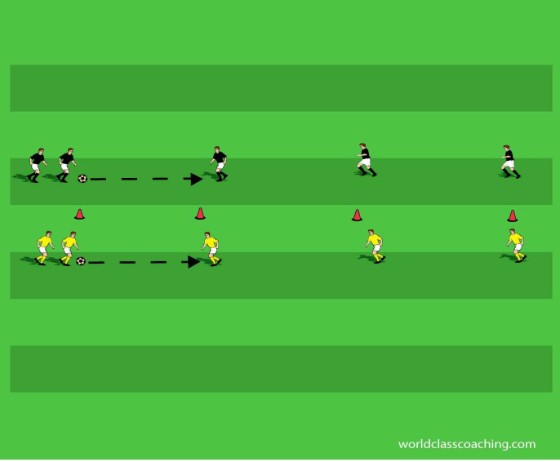
Passing Relay - 15X30 yard area
Divide the group into two teams and spread them out in two lines, with 5-10 yards (depending on age and ability) between each player. Each team gets a ball to start at one end of their line. The object of the game is to pass the ball along the team’s line to the far end as quickly as possible. Each player must stop the ball and pass it in turn. When both teams have worked the ball to the other end of their lines, determine a winner and then play again in the other direction.
Variations:
• each player must take four dribbling touches (in place) before passing to the next player.
• play with the off foot only.
Demonstrate the importance of turning one’s hips and shoulders after receiving to face the next player in line before passing the ball. Encourage players to control the ball and then turn before passing.
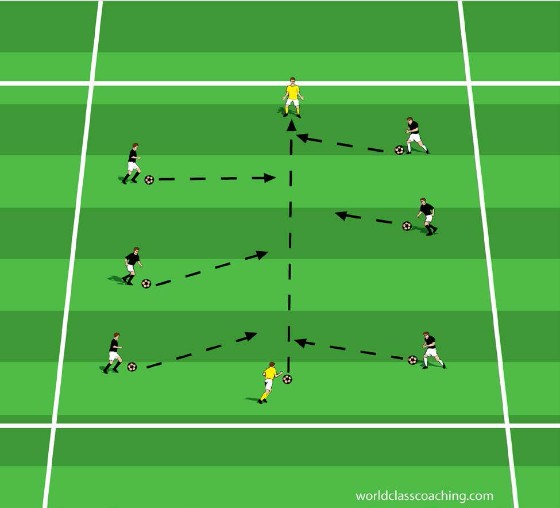
Duck Hunting - ¼ field
Select two players to pass a ball to each other. They stand in the middle of the area, ten yards apart. The remaining players stand with a ball on the side of the area so that they can kick their ball to try to hit the target ball when it is passed. Play once, then the players retrieve their balls and try again from the other side. Play for two minutes and then change the passing pair.
3 vs. 3 To Cone Goals - 25x25 yard field
Play 3 vs. 3 to small cone goals. For the first five minutes, require two passes from the team in possession before they can score. Then remove the restrictions and let the players play.
Training Session#15: Group play
Introduction: This session is designed to continue developing the players’ sense of awareness and ability to support group play. This practice escalates the players’ need to analyze increasing complex playing environments while also having fun learning to work together.
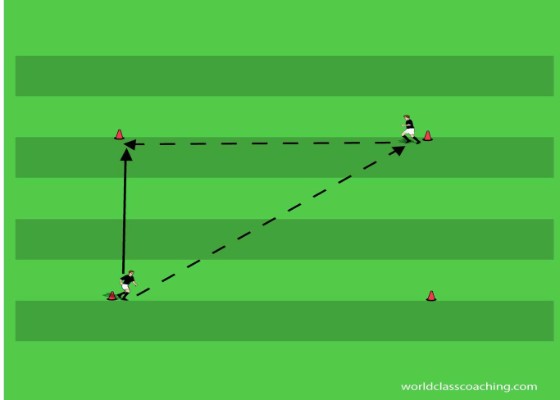
Angled passing in a grid - 10x10 yard grids
Build enough grids so players can work in pairs. Demonstrate with one group. Players start at opposite corners of the grid (see diagram). One player has the ball. This player passes at an angle to her partner, who receives with one touch and then plays straight ahead to her partner, who has sprinted over to the opposite corner on her end of the grid. After each pass, the players sprint to the other corner on their end, so that one player always plays straight and one at an angle.
Coaching cues and progression:
• having the players sprint to a pre-determined point compels them to learn to play to a moving target. It’s a bit easier because they are still playing to a fixed point, but there is still timing involved and players should learn to play with a sense of rhythm.
• the pace of the pass is critical. If they play too hard and/or too early, play will break down. If they delay or play with insufficient pace, their partner will be waiting for the ball at the cone, and the coach must encourage players to find the proper pace.
• the preparation touch is also important. Players must prepare the ball in the direction in which they intend to play. The first touch must get the ball out of their feet to allow them to play the proper ball on a consistent basis.
• play for two minutes and then have the players change roles (i.e. so that the player who was playing straight ahead is now playing at an angle and vice versa).
• play a second round, encouraging players to use one touch where possible. They will need to take a bit of pace off of the ball to allow the runner time to get to the cone.
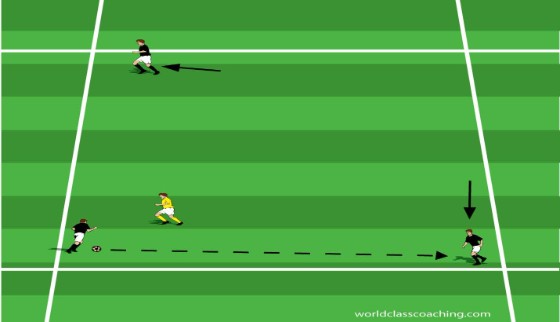
3v1 passing in a grid - 12x12 yard grids
Build grids so that there are enough to place groups of four with one soccer ball. Start with players on three of the corner cones and one player, the defender, in the middle. Demonstrate with one group. Explain that in this environment, players must pass only to the corner cones and that all passes must travel along the perimeter of the grid. Similarly, the attackers may only move along the perimeter of the grid. The defender may move freely within the area of the grid. Start the ball in a corner with one of the attackers.
Show that the attacker must always have two passing options available by moving the attackers not in possession to the adjacent corners of the grid. Begin the exercise by having the defender work at ½ speed so that the attackers get a rhythm and lots of repetition. If the defender wins the ball, have her return it to any of the attacking players. Rotate the defender every minute. After every player has taken a turn at the defender role, play through again, this time with the defender playing full speed after the first pass. Once again, if the defender wins the ball, she should return it to one of the perimeter players to restart play. This exercise is useful both to give some technical pressure to both passing and receiving, and also to begin the tactical building blocks of movement off of the ball and creating useful passing angles.
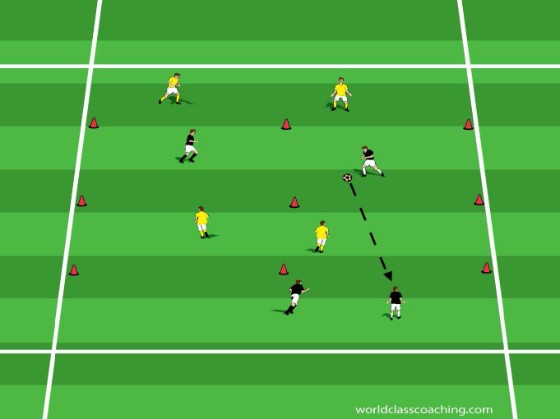
4-zone passing - (4) 12x6 yard grids
(U8+)Divide the group into two teams and place ½ of each team in two grids (one end grid and the middle grid on the opposite side –see diagram). The other team occupies the remaining two grids. Explain that the purpose of the game is work on passing to teammates in the other grid. All players must stay in the grid where they start the game. The team not in possession attempts to intercept passes and then play to their teammates in the other grid. Encourage players to pass within their grid to create a passing angle to the other grid. Give one point for each successful pass across the opponent’s grid.
Variation:
• the defending team can send one player in to the zone of the team in possession to try to win back the ball.
5v5 to goals - full field
Play a full-sided scrimmage, deploying two teams in the team’s chosen arrangement (typically 2-1-2 or 2-2-1 – no goalkeepers). For the first half of the scrimmage, impose a pair of restrictions (one at a time):
• All players on the team must touch the ball when the team gains possession before a goal can be scored.
• 3 passes must be completed before a goal can be scored,
Once the players have shown the ability to focus on group play, remove the restrictions and let them play.
Training Session#16: Receiving out of the Air
Introduction: Session#16 introduces the idea of receiving the ball out of the air. This is one of the most difficult of concepts for young players, who are still developing their motor coordination and often misjudge the ball. Most young players are a bit scared of the ball as well, and this session is designed to help improve motor perception of the ball and also learn to take the ball on the body, reducing the fear element as well.
Bounce juggle - 20x20 yard area
Each player has a ball. This is an activity designed to introduce players to juggling the ball. For young players, reacting to a ball in the air is an evolutionary process and this first challenge allows them to begin to work on their touch and to often experience some success as well. Players begin holding the ball at shoulder height. They allow it to drop and bounce and then try to use their laces surface to play the ball straight up in the air (not very high – usually waist high is a good starting point) and then the ball is allowed to bounce before they strike it again. Allow the players some time to experiment with and develop rhythm and touch. How many bounce juggles can they complete consecutively? The surfaces used in this progressing (laces, thighs, head) are three of the four standard surfaces (along with the chest) for receiving out of the air.
Progression:
• alternate the striking foot
• touch the ball with the thigh after one bounce, then the foot after a bounce, followed by a touch with the other thigh and finally the other foot (pattern repeats).
• Alternate between a touch with the head and one with a foot. When heading the ball, players should be instructed that safety is the primary focus at this age. Players should have their eyes open and mouths closed when heading and they should contact the ball at the hair line on their forehead.
Can they create other patterns?
Pairs receiving out of the air - touch line area
Players work in pairs along a touch line, with one player on the line and another on the field facing her, two yards away. Players on one side serve to their partner (underhand serves) for her to receive, settle to the ground and pass back. After ten repetitions, players change roles.
Progression:
• receiving with the laces. The receiving player gets in line with the ball, presents the foot to be used to receive the ball, contacts and cushions the ball by lowering the foot at the moment of contact, and settles the ball to the ground. Players should learn to receive the ball with the outer half of their laces, pushing the ball into space outside of and in front of either foot. This first touch puts the ball in a position to avoid immediate pressure and also to be able to pass the ball with the second touch (where as dropping the ball between the feet often requires an extra touch to put the ball in a position from which one can pass). Instruct servers to toss to alternating feet on the working player.
• receiving with the thighs. The receiving player gets in line with the ball, presents the thigh to be used to receive the ball, contacts and cushions the ball by lowering the foot at the moment of contact and settles the ball to the ground. Players should learn to receive the ball with the outer half of the thigh pushing the ball into space outside of and in front of either foot. This first touch puts the ball in a position to avoid immediate pressure and also to be able to pass the ball with the second touch (where as dropping the ball between the feet often requires an extra touch to put the ball in a position from which one can pass). Instruct servers to toss to alternating thighs on the working player.
• receiving with the chest. The receiving player gets in line with the ball, pushes her chest forward and shoulders back, contacts and cushions the ball (contact point is the high center chest boney spot well below the base of the neck) by pushing the shoulders forward and guiding the ball to the ground. Players should learn to turn to one side above their waste, pushing the ball into space outside of and in front of either foot. This first touch puts the ball in a position to avoid immediate pressure and also to be able to pass the ball with the second touch (where as dropping the ball between the feet often requires an extra touch to put the ball in a position from which one can pass). Instruct the active player to turn the ball to alternating sides with each serve.
• receiving the ball with the head. Although this is a technique that is rarely used (most often the ball is driven with the head rather than controlled with this surface), it is a useful introduction to heading for young players and a skill that can be very useful in game situations. Once again, the receiving players should be instructed to keep their eyes open and their mouth closed for safety. In this sequence and to learn to control the ball with the head, the server will continue to serve a ball for the active player to receive, but the goal, rather than settling the ball to the ground, will be to see if the active player can get the ball to stop, even briefly, on her head. This involves cushioning (the ball may bounce on the head a bit, but players should try to get shorter bounces with each touch) the ball with good balance. For this exercise, the players should alternate server/active player roles with each toss. Can anyone get the ball to settle on their head and stay there?
Individual collections - 20x20 yard grid
Each player has a ball. This exercise adds movement to the receiving. Players dribble around the area. Every 5 touches, they pick up the ball, toss it up high and settle the ball using any of the surfaces trained in the previous exercise.
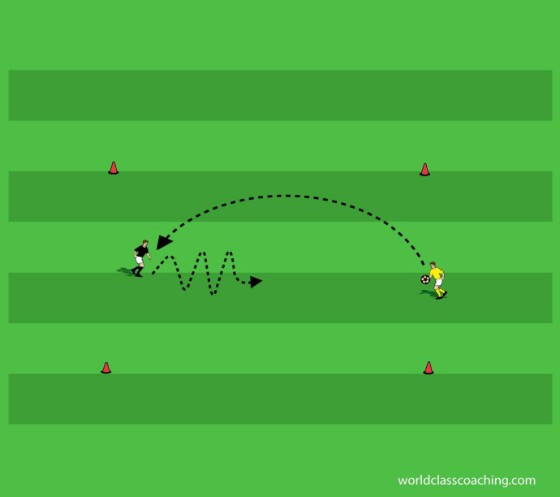
1 vs. 1 with throw-in restarts - 10x10 yard grids
Put two players at each end of the grid as shown. A ball supply is located at one end. The server restarts play with a throw in to her opponent, who settles the ball out of the air. The two players then duel, trying to dribble the ball over one-another’s end lines. When the ball leaves the grid, the duel is over. The two players change ends and the next duel begins.
3 vs. 3 games on a narrow field with throw-in restarts - 15x25 yard fields
Play small-sided games on narrow fields (to create more throw-in opportunities) to small cone goals. All re-starts are throw-ins and the target player for each throw is allowed one free touch before other players are live. Players should focus on receiving the ball and settling it. Mid way through the scrimmage, remove the restriction and allow free play.
Training Session#17: Group play
Introduction: This group play session continues the theme of raising players’ awareness of – and ability to use – their teammates to increase team success in possession.
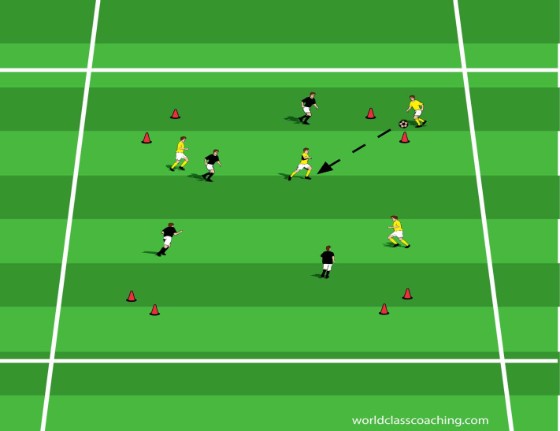
Gates - 30x30 yard grid
Create two equal teams (one in vests). The coach will need to have a supply of balls near the perimeter of the grid for restarting play when the ball leaves the grid. The two teams play a possession game inside the grid with the goal of passing the ball through any of the “gates” (pairs of cones one yard apart scattered throughout the grid as shown in the diagram).
Rules and coaching points:
• to score, a pass must travel through a gate and be received by a teammate on the other side.
• explain to the players before beginning that it is very easy to defend a single gate as a defender can simply stand between the cones. Therefore, the teams need to look to possess the ball with an eye toward working to find an open gate. If a gate draws a defender, the attackers must look elsewhere.
• the most common breakdown in this game is a tendency to crowd the ball. The coach should stop the action if need be a couple of times early on to demonstrate the need to spread out the game. Longer passes typically create open gates and relieve pressure for the attackers.
Play for ten minutes, using the game to assess the team’s ability to possess the ball under pressure.
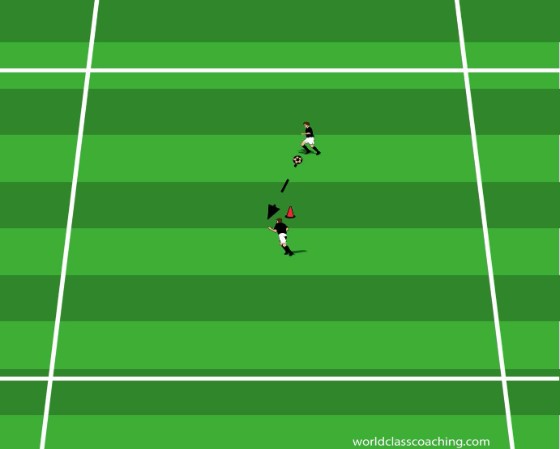
Pairs pass and receive with a cone - 20x30 yard area
Arrange players in pairs with a ball. One player stands on the touchline with the ball and her partner stands behind a cone placed four yards from the touchline. Demonstrate with one pair. The player behind the cone works on the balls of her feet, alternately stepping around one side of the cone and then the other to receive. In receiving, she needs to touch the ball around the cone and play back on the other side. For example, if she steps around to her right, she should receive with the inside of the right foot and touch the ball behind the cone (forward, at an angle) and play back to her partner on left side of the cone using her left foot. Play for one minute and then change roles.
Variations:
• play one touch for the working player.
• play one touch for both players. This requires a very high work rate for the active player and will require rotation after thirty seconds.
No pressure possession in groups - ½ field
Put the players in two teams (one in vests). Each team has a ball. This environment is designed to allow players to focus on: Their technical ability; their speed of play; their communication; and their movement off of the ball. The two teams play in the field at the same time (they do not interfere with the other team’s possession). Play each of the following variations for two minutes.
• communication. Before a pass can be made, the passer and the target must get eye contact (visual) and call out one-another’s names (verbal communication).
• pass and sprint. As the team knocks the ball around, the player who just passed the the ball makes a five yard sprint away from the ball. Emphasize that all players must continue to jog and to use the entire space as their team plays. Explain that these rules apply throughout the exercise.
• off foot only. Require players to both pass and receive with their off foot.
5v5 with Scatter Rule - full field
Play a regular scrimmage (without goalkeepers), deploying the team in the chosen formation. For the first few minutes of the scrimmage, after passing the ball, players must run around a corner flag (nearest or any or furthest – mix it up for the players) before rejoining play. This restriction helps limit the bunching so common in games among young teams. Mid way through the scrimmage, remove the restriction and let the players play.
Training session#18: Finishing
Introduction: This final session in the U9-U10 curriculum is intended as a reinforcement of players’ good habits in striking the ball, with an emphasis on playing around the goal and finishing in particular.
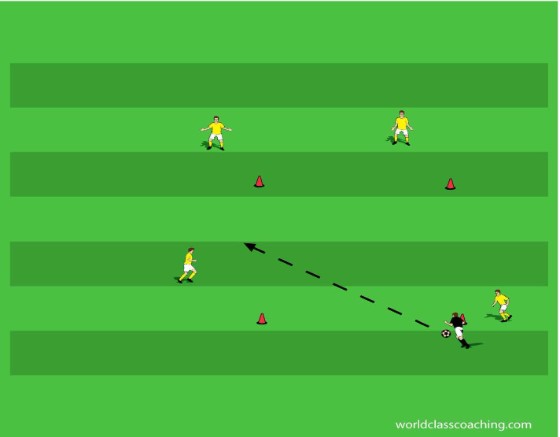
Soccer kickball - ½ field
Divide the group into two teams. The game is played similarly to kickball, with the batter kicking the ball and then trying to touch all 3 bases and return to home plate. The fielding team must run down the ball and return it to the home plate cone before the runner gets there. Each team bats around and then rotates to the field.
Variations:
• the fielding team, to create an out, must run down the ball and then pass it amongst themselves until all team members have touched the ball before the runner returns home.
• batters must use their ‘off’ foot.
Pairs passing and shooting progression - ¼ field
Players work in pairs with one soccer ball per pair and along the touch-line. Instruct each pair to start and stay four yards apart. The following progression is designed to both give players numerous striking touches and also provide them with a useful tutorial in learning to select a finishing surface. Play each sequence for two minutes, focusing upon proper technique, accuracy and also assuring that players alternate the striking foot each time they play.
• two-touch passing. Using the inside of the foot, players ping the ball back and forth with their partner. Emphasize speed and quality of footwork and striking.
• one-touch. Using the inside of the foot again, players knock the ball back and forth with their partner, alternating the striking foot with each touch. Players use one touch where possible and two touches when necessary to sustain the exercise.
• laces striking: Short distance. Demonstrate with one pair proper use of the laces surface to strike the ball. Explain that this surface allows for the greatest striking power, but also creates more room for error, as the laces surface is more narrow and inherently less stable than the inside surface of the foot. Therefore, players must work very hard to develop consistency in striking with their laces. The technical cues for striking with the laces are:
1. lock the ankle with the toes pointed at the ground.
2. place the plant foot next to the ball, below the shoulder, assuring that the toes of the plant foot point in the direction of the target.
3. encourage players to put their knee in a firm position as well and consider their hip as the point of rotation. Players should practice this striking motion without a ball to begin, holding their foot on the follow-through to check their form.
• laces striking: Medium distance. Move the players back so that the pairs are working with ten yards between them. Players continue to strike the ball with their laces, alternating feet with each strike. Continue to emphasize accuracy and proper technique.
The most common technical errors are:
• the ball pops up in the air. This indicates that the player is striking the ball at a low point, causing the ball to fly upward off of her foot. This player needs to strike the middle-back of the ball to keep it traveling on the ground.
• the ball consistently travels wide of the target. Here, the player is typically either playing with the plant foot pointed away from the target or failing to strike the ball on the center back, so that the ball spins off of the laces to one side.
• the ball does not travel the distance. Here the player is typically failing to lock her ankle and/or knee or she is not striking the ball with sufficient force.
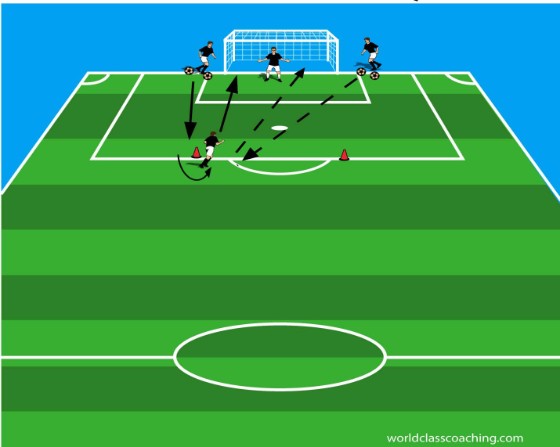
Pass/Shoot/Play GK - goal box area
Create two even teams and have them collect balls just outside the posts. One player starts in goal. A player from the other team runs around the cone 10 yards from goal and then receives a pass from the opposing line. The attacking player takes a touch to set the ball and then takes a shot at goal. The shooter then plays goalkeeper for one turn and the passer becomes the attacker. Urge players to remember to move to their next role quickly and to restore the ball supply after playing goalkeeper. Keep track of goals scored for each team.
Variations:
• one-touch shooting
• give points for great saves
• rebounds are live
• only goals scored in the air count
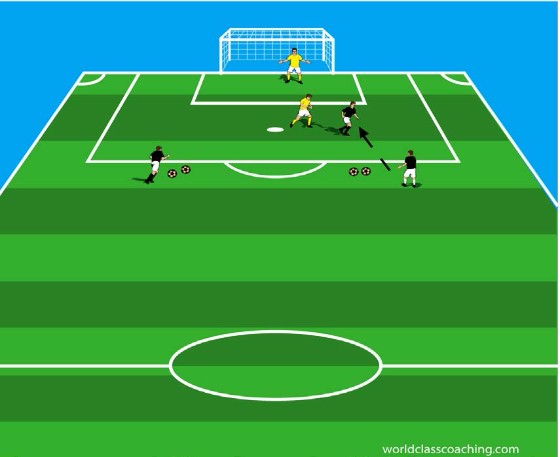
1v1 Hotbox - large goal box
Place two players (plus a goalkeeper for U8) inside the box. BothPlayers are trying to score at all times (while preventing their opponent from scoring). The remaining players act as servers and line up with balls around the edge of the area. The coach indicates which server should introduce a new ball each time the ball leaves the area. Play for two minutes and then rotate the middle pair.
Multiple balls game with no goalkeepers - ½ field
Divide the group into two teams. Explain that either team may score in eitherof two goals at the ends of the field. The ball remains live while it is within the grid. All re-starts should come from the coach, who keeps a ball supply along the perimeter near the center of the field. The coach should keep at least two balls in play at all times. Encourage players to both play defense when the other team has the ball and also to attack either goal and shoot whenever they have the opportunity. Keep track of goals scored and play for five minutes.
3 vs. 3 to goals - 20x20 yard fields
Play 3 vs. 3 to cone goals. Encourage players to use their laces to finish as in previous exercises. The goals should be full-sized despite the relatively small fields, so that there is frequent opportunity to shoot and to score. Play without goalkeepers and keep score.
Sources and Recommended Reading
Alagich, Richard. Soccer: Winning Through Technique and Tactics. New York, NY: McGraw-Hill, 1996.
Fairclough, Paul. Soccer Strategies. Buffalo, NY: Firefly Books, 2009.
Fleck, Tom, and Ron Quinn. The Baffled Parents’ Guide to Great Soccer Drills. Camden, ME: Ragged Mountain Press, 2002.
Galustian, Alf and Charlie Cooke. A New Era: A Coerver Coaching Masterclass Series. Sportsmethod, 1998.
Green, Shaun. Soccer Made Easy: Coaching 9-12 Year Olds. Spring City, PA: Reedswain, 2002.
Gregg, Lauren. The Champion Within: Training for Excellence. Burlington, NC: JTC Sports, 1999.
Harrison, Wayne. Full Season Training Program: A Complete Season of Training Sessions for a Competitive U12 Team. Leawood, KS: World Class Coaching, 2007.
Kormelink, Henny and Tjeu Seeverens. Developing Players the Dutch Way. Spring City, PA: Reedswain, 1996.
NSCAA. State Diploma. Course materials.
NSCAA. Regional Diploma. Course materials.
NSCAA. Advanced Regional Diploma. Course materials.
NSCAA. Coaching Soccer. Edited by Tim Schum. Indianapolis, IN: Masters Press, 1996.
Rees, Roy. The Manual of Soccer Coaching. Spring City, PA: Reedswain, 1995.
Rees, Roy and Cor Van Der Meer. Coaching Soccer Successfully. Champaign, IL: Human Kinetics, 1997.
Success in Soccer (DFB). Basic Training:Techniques and Tactics for Developing the Serious Player. Munster, Germany: Philippka Sportverlag, 2002.
Success in Soccer (DFB). Modern Youth Training: The Complete Guide to Soccer for Kids. Munster, Germany: Philippka Sportverlag, 2006.
Stoop, Tino. Coaching Under 10’s: A Complete Coaching Course. Spring City, PA: Reedswain, 2003.
United States Soccer Federation. Soccer: How to Play the Game: The Official Playing and Coaching Manual of the United States Soccer Federation. New York, NY: Universe Publishing, 1999.
Wein, Horst. Developing Game Intelligence. Spring City, PA: Reedswain, 2004.
Wilkinson, Roger, and Mick Critchell. 300 Innovative Soccer Drills for Total Player Development. Spring City, PA: Reedswain, 2000.
About the Author
Tony Englund is the Assistant Director of Coaching at St. Croix Soccer Club. Tony has earned more than a dozen diplomas from the National Soccer Coaches’ Association of America, including the Premier, National Goalkeeping and Director of Coaching awards and he serves as an Associate Staff Coach for that organization. Tony is a frequent presenter at high-level coaching clinics. He has served as Director of Coaching and Player Development with three Minnesota clubs and has more than twenty years’ experience as a successful club, high school and college head coach. His teams have repeatedly earned promotion to the highest levels of state and Midwest Regional League play and won multiple state championships, premier league titles and consistent regional rankings. He is the author of nine books published by WORLD CLASS COACHING.


